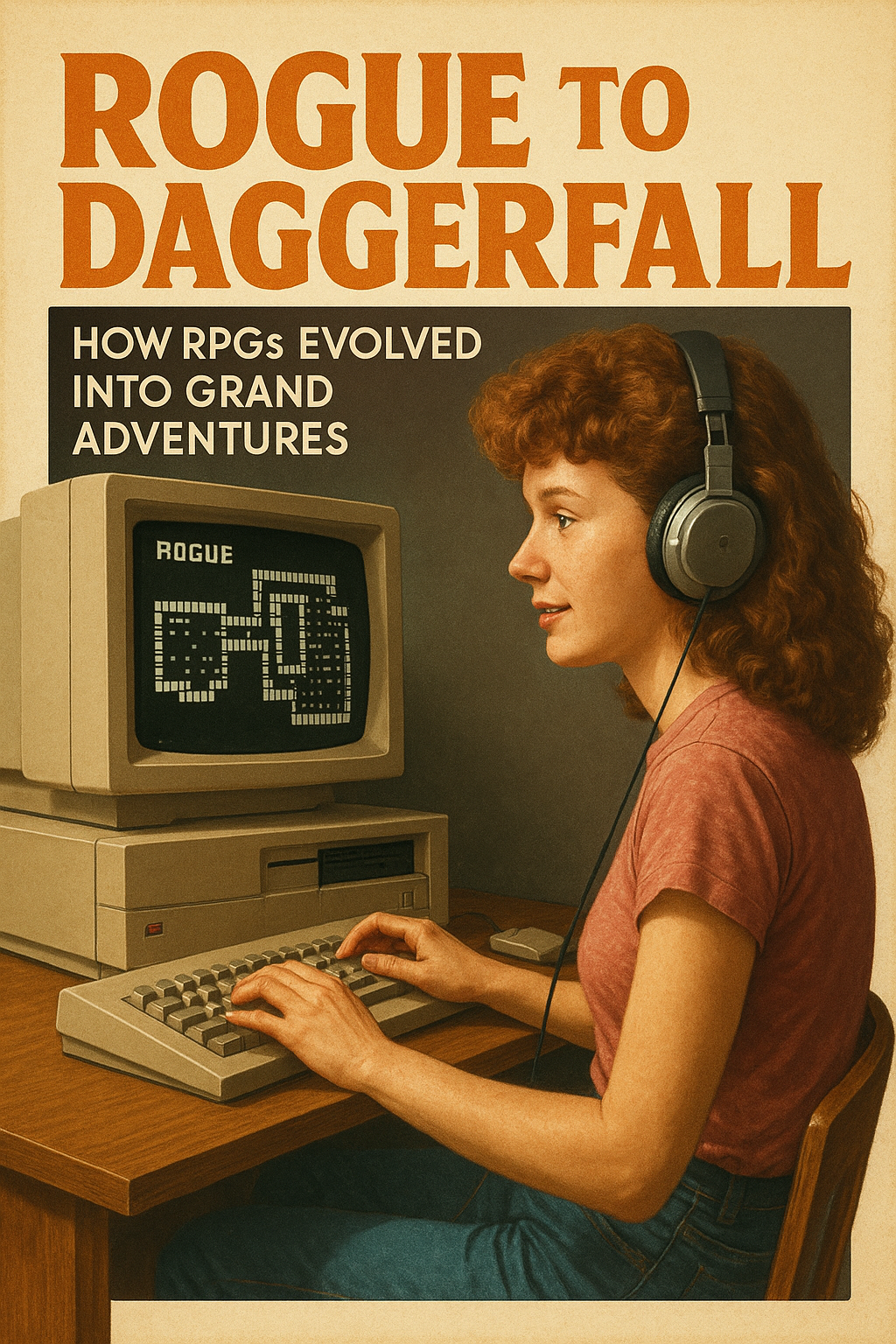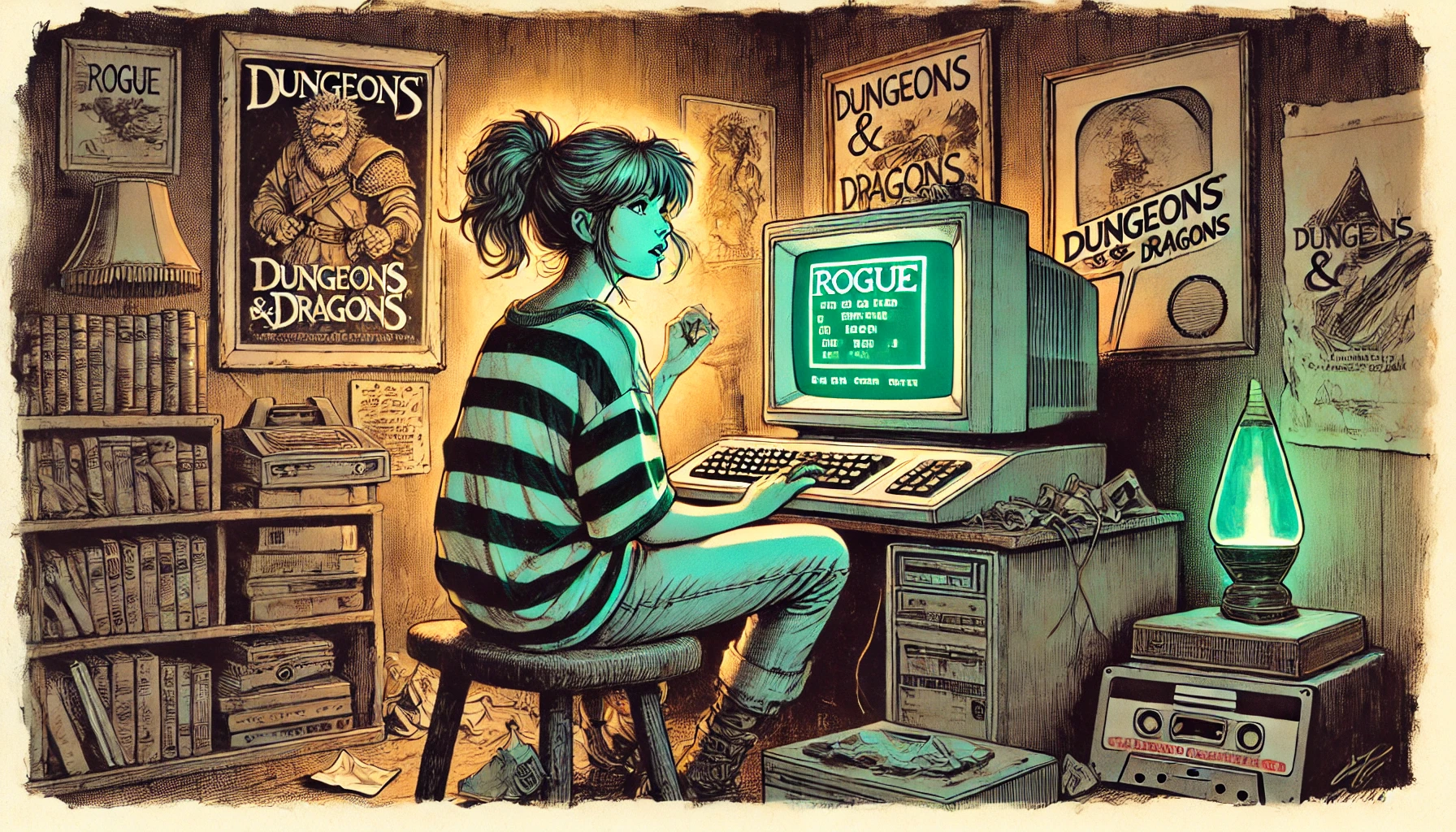Once upon a pixelated time, role-playing games (RPGs) were simple digital dungeons inhabited by ASCII characters. These rudimentary adventures, like the iconic Rogue, captivated players with their endless possibilities and groundbreaking procedural generation. Fast forward, and we find ourselves amidst the expansive, richly detailed worlds of games like Daggerfall, where players can explore vast landscapes and engage in intricate narratives. This evolution from minimalist dungeon crawlers to sprawling adventures is a testament to the enduring appeal of RPGs and their relentless innovation in gaming.
The charm of RPGs lies in their ability to transport players to otherworldly realms filled with challenges, treasures, and tales waiting to be uncovered. From the straightforward quests of yesteryears to the complex storylines of today, RPGs have continuously evolved, offering players deeper engagement and ever-expanding worlds. As technology advances, so do these virtual adventures, perpetually pushing the boundaries of storytelling and player immersion.
At the heart of this evolution is the RPG community’s insatiable appetite for innovation. Developers have embraced this demand, crafting experiences that not only challenge the player’s abilities but also their imagination. The evolution from Rogue to Daggerfall is just one chapter in the ongoing saga of RPGs, a genre that, despite its long history, continues to reinvent itself and captivate new generations of gamers.
As we embark on a journey through the history of RPGs, we’ll explore their origins, the rise of narrative complexity, the introduction of innovative mechanics, the allure of open worlds, and the role of technology in shaping these grand adventures. So, grab your virtual sword and shield, and let’s delve into the enchanting evolution of RPGs.
Origins of Role-Playing Games
In the early 1980s, the world of computer RPGs began with humble origins. Titles like Rogue set the stage for the genre by introducing procedural generation—a revolutionary concept at the time, allowing for endless replayability. With its simplistic ASCII graphics, Rogue offered players an experience driven by imagination, as they ventured through randomly generated dungeons, battling monsters and collecting treasures.
Games such as Rogue laid the groundwork for future innovations by providing the core structure of dungeon exploration and character progression. The simplicity of the graphics did not deter players; instead, it encouraged them to immerse themselves in the gameplay and create their own narratives. This foundation inspired a generation of developers to expand upon these mechanics, paving the way for more complex and visually appealing games.
The success of these early RPGs demonstrated the potential of video games as a storytelling medium. Despite technological limitations, developers realized that the heart of the RPG experience lay not in the graphics but in the player’s ability to explore, strategize, and create their own adventures. This realization spurred a wave of innovation, leading to the diverse and expansive RPGs we enjoy today.
The Rise of Narrative Complexity
As RPGs matured, the focus began to shift from simple dungeon crawls to rich narratives and complex character development. Games like Ultima and Final Fantasy pioneered storytelling in RPGs, offering players intricate plots, memorable characters, and moral dilemmas. These games transformed the player’s role from mere adventurer to a hero whose choices shaped the world around them.
The inclusion of deep narratives and character arcs enhanced player engagement, as gamers became emotionally invested in the stories unfolding before them. This evolution marked a pivotal moment in RPG history, as it highlighted the importance of storytelling in immersing players and maintaining their interest. The influence of these narrative-driven games is evident in modern RPGs, where plot and character development are integral to the gaming experience.
As players grew more invested in the stories and characters, developers faced the challenge of balancing narrative depth with engaging gameplay mechanics. This balance remains a hallmark of successful RPGs, where players are drawn into richly woven tales while enjoying the strategic and exploratory elements that define the genre.
Introducing Innovative Mechanics
The evolution of RPGs is closely tied to the introduction of innovative mechanics that transformed gameplay experiences. As developers sought to enhance player engagement, they incorporated features like character customization, skill trees, and non-linear quests.
- Character Customization: Games like Baldur’s Gate allowed players to create and personalize their avatars, fostering a deeper connection with their in-game personas.
- Skill Trees: Diablo II introduced skill trees, offering players the freedom to tailor their character’s abilities and playstyle.
- Non-Linear Quests: The Elder Scrolls: Morrowind revolutionized quest design with its open-ended approach, giving players the freedom to tackle quests in any order.
- Real-Time Combat: Secret of Mana broke away from turn-based combat, offering a dynamic real-time battle system.
- Companion AI: Dragon Age: Origins featured AI-controlled companions whose relationships with the player impacted the storyline.
- Branching Narratives: The Witcher 3 showcased branching storylines shaped by player decisions, adding depth and replayability.
- Crafting Systems: Monster Hunter introduced crafting, allowing players to forge weapons and armor from materials collected in the game.
- Moral Choices: Mass Effect emphasized moral choices, influencing the game’s outcome and player alliances.
- Open-World Exploration: The Legend of Zelda: Breath of the Wild set a new standard for open-world exploration, encouraging players to discover secrets at their own pace.
- Dynamic Weather Systems: Red Dead Redemption 2 incorporated realistic weather effects that impacted gameplay and immersion.
- Procedural Generation: No Man’s Sky leveraged procedural generation to create a vast and diverse universe for players to explore.
- Stealth Mechanics: Deus Ex introduced stealth mechanics, allowing players to choose between combat and stealth approaches.
- Dialogue Wheels: Mass Effect popularized the dialogue wheel, enabling players to shape conversations and character interactions.
- Time Travel: Chrono Trigger used time travel as a core mechanic, affecting the game’s world and story outcomes.
These innovative mechanics not only enhanced player agency but also increased replayability, encouraging players to experiment with different approaches and strategies. As a result, RPGs became more diverse and dynamic, offering players a wealth of experiences to explore.
The Emergence of Open Worlds
The emergence of open-world design in RPGs marked a significant evolution in the genre, offering players unparalleled freedom and exploration. Titles like Daggerfall expanded the scope of the player’s journey, providing vast landscapes to roam and countless quests to undertake.
| Game Title | Defining Features | Innovations Brought |
|---|---|---|
| The Elder Scrolls II: Daggerfall | Expansive world, procedural generation | Pioneered open-world exploration |
| The Witcher 3: Wild Hunt | Dynamic storytelling, branching narratives | Set standards for narrative-driven worlds |
| The Legend of Zelda: Breath of the Wild | Non-linear exploration, physics-based puzzles | Revolutionized open-world gameplay |
| Red Dead Redemption 2 | Realistic environments, dynamic weather | Enhanced immersion and realism |
| Grand Theft Auto V | Open-world sandbox, diverse activities | Popularized open-world urban settings |
| Skyrim | Endless quests, modding community support | Cultivated a dedicated fan base |
| Fallout 4 | Post-apocalyptic setting, base-building | Expanded player creativity and agency |
| Horizon Zero Dawn | Rich ecosystems, engaging combat | Blended open-world and action RPG elements |
| Ghost of Tsushima | Authentic cultural depiction, exploration freedom | Immersive historical setting |
| Assassin’s Creed: Odyssey | Role-playing elements, branching storylines | Merged historical settings with RPG mechanics |
| Cyberpunk 2077 | Futuristic setting, deep customization | Pushed technological boundaries |
| No Man’s Sky | Infinite universe, procedural generation | Realized the potential of limitless worlds |
The allure of open worlds lies in the limitless adventures they offer players. With the freedom to explore at their own pace, players can uncover hidden stories, engage in dynamic quests, and shape their own destinies within these expansive environments.
The appeal of open-world RPGs extends beyond their vast landscapes. These games provide players with a sense of agency and empowerment, allowing them to write their own stories within the game’s universe. As open-world design continues to evolve, so too does the potential for even grander adventures and more immersive experiences.
The Role of Technology in RPG Evolution
Advancements in technology have been a driving force in the evolution of RPGs, enhancing graphical fidelity, AI capabilities, and online connectivity. As technology progressed, so did the potential for creating more realistic and engaging RPG experiences.
- 3D Graphics: Enabled the creation of more detailed and visually stunning worlds.
- Voice Acting: Added depth to character interactions and storytelling.
- Motion Capture: Brought lifelike animations to characters and creatures.
- Artificial Intelligence: Improved NPC behavior and companion dynamics.
- Cloud Gaming: Allowed players to access RPGs on various devices without powerful hardware.
- Virtual Reality: Offered immersive, first-person RPG experiences.
- Physics Engines: Created realistic interactions between characters and environments.
- Ray Tracing: Enhanced lighting and shadows for greater realism.
- Procedural Generation: Enabled the creation of vast, unpredictable worlds.
- Cross-Platform Play: Connected players across different gaming systems.
- Enhanced Sound Design: Added depth and atmosphere to game worlds.
- Modding Support: Empowered players to create custom content and expand game longevity.
- Online Multiplayer: Facilitated cooperative and competitive RPG experiences.
These technological advancements have not only enriched the visual and auditory aspects of RPGs but also expanded their scope and depth. As technology continues to evolve, so too will the potential for creating even more captivating RPG experiences.
The future of RPGs is bright, with ongoing technological innovations promising to push the boundaries of what’s possible. From more immersive virtual reality experiences to AI-driven narratives, the potential for RPGs to captivate and engage players is limitless.
Crafting Immersive Worlds
Creating immersive worlds is a delicate art that requires attention to detail, cohesive lore, and cultural depth. Game designers meticulously craft environments that draw players into the world, making every corner of the map feel alive and significant.
| World-Building Element | Example RPGs | Impact on Player Immersion |
|---|---|---|
| Detailed Environments | Skyrim, Witcher 3 | Enhances exploration and discovery |
| Cohesive Lore | Dark Souls, Dragon Age | Provides a rich narrative foundation |
| Cultural Depth | Ghost of Tsushima, Witcher 3 | Adds authenticity and believability |
| Dynamic Ecosystems | Horizon Zero Dawn, Red Dead Redemption 2 | Creates a living, breathing world |
| Atmospheric Sound Design | Bloodborne, The Elder Scrolls V: Skyrim | Deepens emotional connection and immersion |
| NPC Interactions | Mass Effect, Fallout | Fosters player engagement and agency |
| Mythical Creatures | Monster Hunter, Final Fantasy | Enriches world diversity and challenge |
| Historical Influences | Assassin’s Creed, Kingdom Come: Deliverance | Grounds the world in reality and history |
| Weather Systems | The Legend of Zelda: Breath of the Wild | Adds realism and influences gameplay |
| Architectural Design | BioShock, Dragon Age | Situates players within believable settings |
| Quest Diversity | Witcher 3, Cyberpunk 2077 | Offers variety and replayability |
| Theme and Atmosphere | Dark Souls, Bloodborne | Establishes tone and mood |
These elements of world-building are crucial in crafting RPGs that captivate players and encourage them to lose themselves in the game’s universe. The artistry behind these designs is a testament to the creativity and passion of game developers who strive to create worlds that resonate with players long after they’ve set down the controller.
As players explore these immersive worlds, they become part of a larger narrative, contributing to the stories and legends that define the RPG experience. The beauty of these crafted worlds lies in their ability to inspire, challenge, and transport players to realms of endless imagination.

RPGs Across Cultures
RPGs from different cultures bring diverse perspectives and storytelling styles, enriching the genre and expanding its global appeal. Games like Persona from Japan and The Witcher from Poland offer players unique narratives and gameplay experiences that reflect their cultural origins.
These cultural influences can be seen in the themes, characters, and art styles of RPGs, providing players with a window into different worlds and traditions. The blend of cultural diversity within the RPG genre allows for a broader range of stories to be told, appealing to a global audience and fostering a deeper appreciation for different cultures.
By exploring RPGs from various cultural backgrounds, players can gain insight into different storytelling traditions and experiences. This diversity enriches the genre and highlights the universal appeal of RPGs, where players from all walks of life can come together to share in the joy of adventure and discovery.
The cross-cultural exchange within the RPG genre not only broadens players’ horizons but also fosters a sense of connection and understanding among gamers worldwide. As the genre continues to evolve, it will undoubtedly draw from a rich tapestry of cultural influences, creating experiences that resonate with players across the globe.
Player Agency and Game Design
RPGs empower players through decision-making, allowing them to shape the narrative and outcomes of the game. This player agency is a defining feature of the genre, fostering a dynamic storytelling experience.
- Branching Storylines: Games like The Witcher 3 offer multiple endings based on player decisions.
- Dialogue Choices: Mass Effect allows players to guide conversations and relationships with NPCs.
- Moral Dilemmas: Fallout: New Vegas presents players with ethical choices that impact the game’s outcome.
- Character Customization: Dragon Age: Inquisition lets players define their hero’s appearance and abilities.
- Faction Alignments: Skyrim allows players to align with different factions, influencing the game’s world and politics.
- Open-Ended Quests: The Legend of Zelda: Breath of the Wild encourages players to tackle challenges in any order.
- Multiple Playstyles: Deus Ex supports both stealthy and aggressive approaches to gameplay.
- Companion Influence: Dragon Age: Origins features companions whose relationships impact the storyline.
- Reputation Systems: Fable tracks player actions, affecting how NPCs react to the protagonist.
- Non-Linear Exploration: Red Dead Redemption 2 offers a vast world for players to explore at their leisure.
- Sandbox Elements: Minecraft lets players build and shape their world, fostering creativity.
- Dynamic World Changes: Cyberpunk 2077 features a world that reacts to player actions.
- Narrative Branching: Heavy Rain allows player choices to shape the narrative’s direction.
These elements of player agency contribute to the dynamic storytelling experience that defines RPGs. By allowing players to influence the game’s world and narrative, developers create experiences that are both personal and engaging.
The power of player choice in RPGs lies in its ability to create unique narratives for each player. This personalization enhances the gaming experience, making it more immersive and replayable as players explore different outcomes and storylines.

Final Thoughts on the Evolution of RPGs
The journey of RPGs from Rogue to Daggerfall is a testament to the genre’s capacity for innovation, creativity, and player engagement. As we reflect on the past, present, and future of RPGs, we see a genre that has continuously evolved to meet the demands of players and embrace new technological possibilities.
RPGs have come a long way from their humble origins, offering players richer narratives, more immersive worlds, and greater agency. These elements have kept the genre vibrant and relevant, appealing to both longtime fans and newcomers alike. As technology continues to advance, so too will the potential for RPGs to captivate and inspire players.
The evolution of RPGs is a celebration of the endless adventures that await in the ever-expanding worlds of gaming. With each new title, players are given the opportunity to explore new realms, forge new stories, and immerse themselves in experiences that transcend the boundaries of the virtual world.
As we look to the future, we can expect RPGs to continue pushing the boundaries of what’s possible, offering players even more opportunities for exploration, creativity, and engagement. The adventures are limitless, and the stories yet to be told are as vast as the worlds waiting to be discovered.

